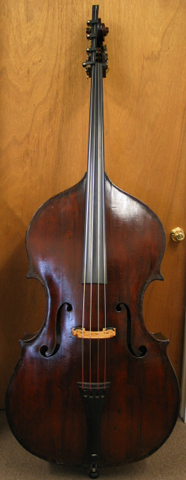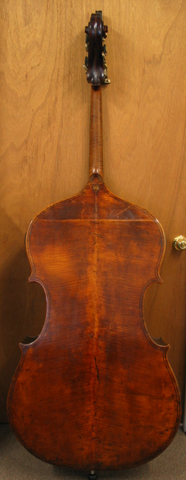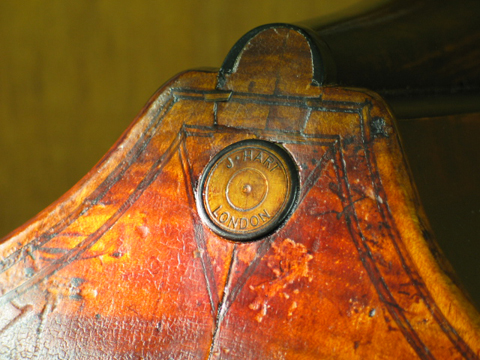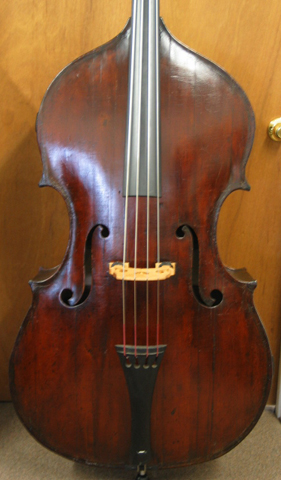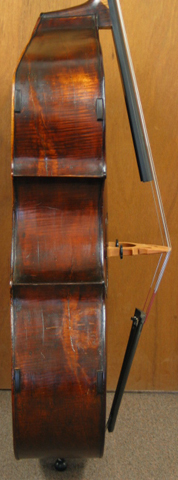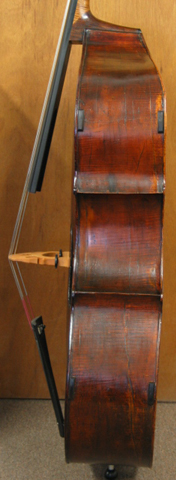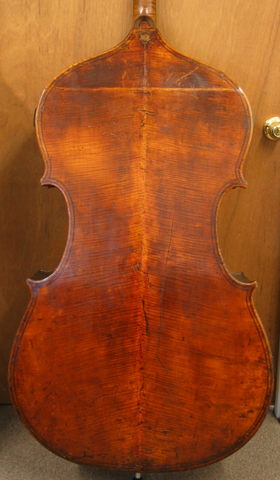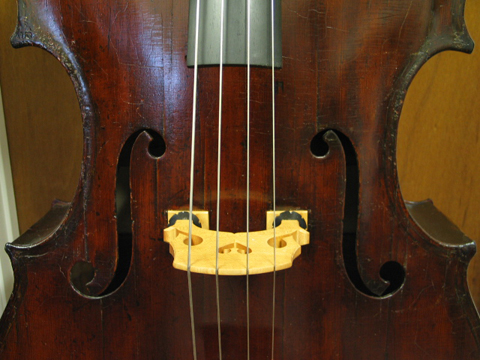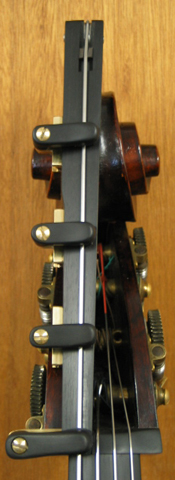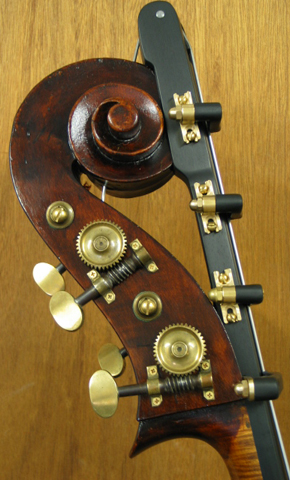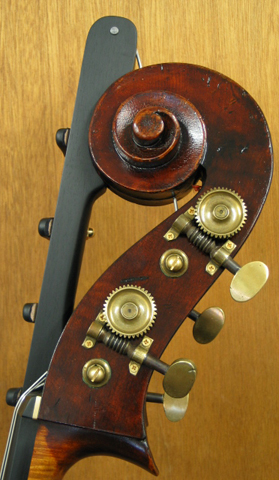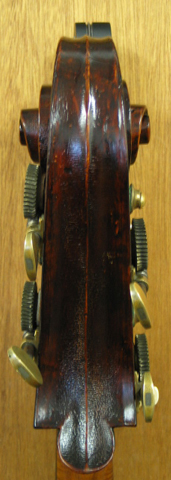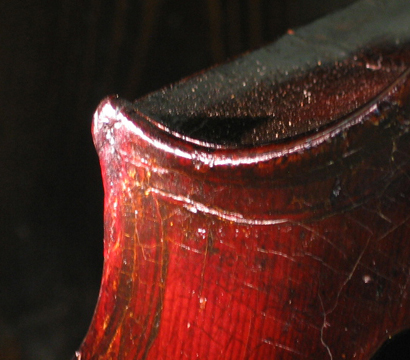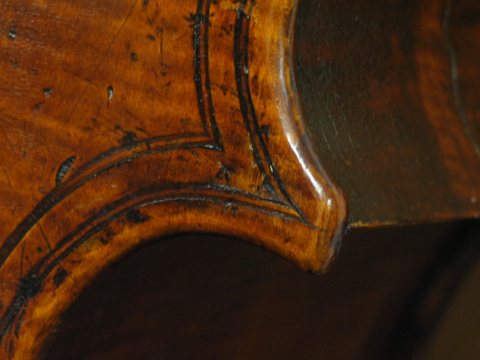John Thomas Hart London, c.1830 Branded "J.HART" inside the Back above and below the center Crossbar (John Thomas Hart, b.Dec. 17, 1805 - d.Jan. 1, 1874)
|
||||
This is a beautiful full 3/4 Maggini model Orchestral Double Bass by John Hart who apprenticed with Samuel Gilkes from 1820-1827. His apprenticeship ended the same year that Gilkes died. This beautiful 'Fendt-like' Double Bass has four (4) small stamps on the inside of the Back on either side of the center Crossbar upper and lower reading "J.HART" in fine lettering of the size you might see stamped on a Bow. I mention Fendt and Maggini in general only as these makers all had an individual style and only have slight similarities as far as the trained eye goes but in general do have resemblance to the average onlooker. Maggini was the apprentice and successor to Gasparo d'Salo (the first Double Bass maker in history) whose model he followed and improved on. In the early to mid 19th century, it was the favored model Double Bass made by British makers like Fendt, Kennedy and even William Gilkes, the son of Samuel and co-worker/trainee with Hart who was about 5 years older than William. During our investigation and research on this Bass we find that John Hart signed a 'Contract of Apprenticeship' in May of 1820 in London at the age of 14 with Samuel Gilkes within one year of Gilkes leaving his employ at the shop of William Forster (1819). His apprenticeship with Gilkes is also noted in many books dating back to the 19th century. One world renowned authority commented to me, "This is one of the greatest archaeological finds in Double Basses in decades!". This Bass also had a Business Card laminated to the lower Rib at the Block under the Varnish by "MESSRS. BIRD & SONS" (c.1890) and an inscribed message inside the lower back from a restoration by 'William Zettwitz', London 1944. MESSRS. BIRD & SONS (Partial Reproduction from Original Card attached by TailBlock, c.1890) Although we have been all over the Fendt name on this Bass as that's what everyone across the globe has called it for the past 35 years or more, these 4 stamps in the Back from 'Hart' would not have been discovered if it were not under a full and diligent restoration. Arnold Schnitzer (Maker/Restorer, NY) while cleaning the dirt caked to the grain of the flamed Sycamore Back discovered these stamps accidentally as he worked with extreme dedication to do the job right. Another important English Double Bass authority believes this may well be the work of the English master John Devereux (c.1850) who was also the maker of many of the Maggini models for B.S. Fendt as well. The night I brought the Hart Bass home I received an email from London. I was told that an identical Bass to mine purchased as a genuine G.P.Maggini was once used for 30 years in the London Symphony by the former Principal Bassist at that time. They later were told that the Bass was actually British and made by William Valentine who according to the 'Will' of J.T. Hart (of which I have a copy of) was referred to as his 'Half Brother' and not his son-in-law as previously believed. While comparing the Scroll and FF-Hole pattern to other Basses by Valentine, Devereux, Fendt, Kennedy, Lott etc., we find that this Bass is truly original in this respect and compares to nothing we have seen before by any other British maker. Since we have conflicting opinions which is not at all unusual in this Business, we are still calling this a John Hart Bass as it is at least agreed that he either made it or had it made for his shop and bears his brand stamp, (J.HART). About Hart and his Master: Samuel Gilkes started his training at an early age with relative Charles Harris Sr. (Harris Sr., one of the best English makers of his time, London 1770-1830 and often alluded to either the "English Lupot" by Jalovec or the "English Amati' by W.Henley) and later (1810) worked for and trained further with William Forster III. Gilkes would later train John Hart. Gilkes also trained or trained with Charles Harris Jr. in the Harris shop. After Gilkes' untimely death, Harris Jr. went to work with Hart for awhile as well. W.E. Hill went to study Violin making with Charles Harris Jr. in 1835 after Harris Jrs' move to Oxford from London (1795-1828). Also, Olde Bird (Bird & Sons) personally introduced Bow maker Samuel Allen to W.E. Hill. Bird was once in possession of this Bass as noted by his card on the lower Rib. He is also an indirect link between Hart, Hill, Gilkes and Harris as they are all connected to either this Bass or the Hart/Hill 'feud' in one way or another as the Harts and the Hills were in stiff competition with each other. The Harts were makers, restorers and dealers. John Hart was the best followed by his son George and Geo.II. Later, the Harts would turn to mainly dealing with John Hart employing his half brother William Valentine who made most of the Hart Basses and some possibly for Fendt as well. Hart & Sons, the later firm also employed the Voller Bros. and others in and out of their shop for Violin making. The Harts became the main dealers and connoisseurs in London of Italian Violins in their time as seen in many books by the phrase 'according to Hart, etc'. This can be seen in many books especially those of English writers but as far as John Hart himself being a maker, his work has rarely been seen. I will update this important page of English Violin/Bass history as things develop. For now, I am calling this Bass the individual work of young John Hart made just after his apprenticeship with Samuel Gilkes and not Bernhard Fendt Sr. as that's where the evidence is pointing. This Bass dates mainly before we see Basses individually from Lott Sr., Kennedy, William Gilkes (who trained with his father Samuel along with Hart) and even Bernard Simon Fendt as they all worked for other makers in the first part of their lives. It is reasonable to speculate that William Gilkes who was about 8-9 years old when John Hart began his apprenticeship may have worked with Hart after the death of his father. W. Gilkes is actually mentioned in the 'Will' of J.T. Hart as well so I do not doubt at least some sort of continued relationship between them. In 1827 when S.Gilkes died, William was still only 16 years old. Hart having trained and worked with his father in the same shop for about 7 years by then was possibly like an older brother of William. A Double Bass by William Gilkes that I know of c.1840 has some similar flavors to it when comparing it to this early work of Hart. According to Thwaites of London, "The work of John Hart, what little has been seen and confirmed ranks equally amongst the likes of Lott and Fendt and can stand along side the 'best' of the London Double Bass Makers". With the exception of this Bass here, most of the other Hart Basses are more likely the work of William Valentine, his half-brother. NOTE: In the book 'History of the Violin' written in 1864 by William Sandys and Simon Andrew Forster (son of William III) both Samuel Gilkes and John Hart are included in the 'Family and School of William Forster' in chapter XXIII. This inclusion attested to by S.A. Forster, the last maker of this Family. For a side by side look at the Gilkes and Hart Basses Click Here |
